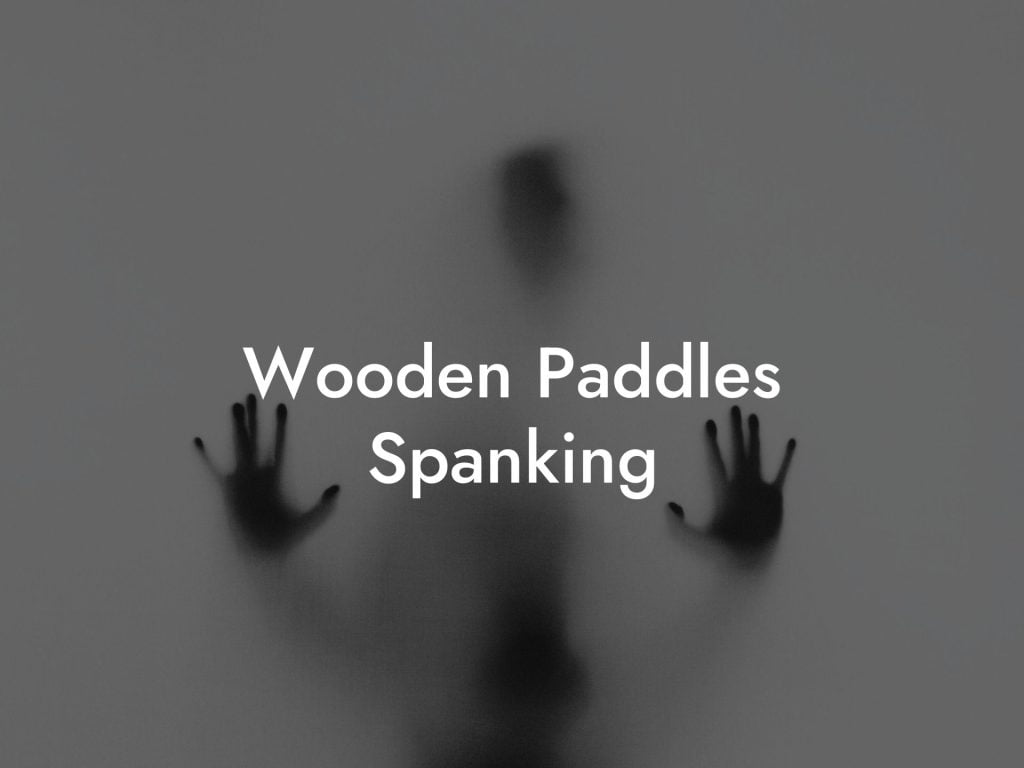Spanking, a form of impact play, has been practiced for centuries and is a popular activity in the BDSM community. From gentle erotic slaps to intense punishment spankings, there are various types of spanking that cater to different desires and preferences. In this article, we will delve into the different types of spanking, exploring their techniques and sensations. Whether you're a seasoned spanker or a curious beginner, this guide will provide you with the knowledge to enhance your spanking experiences.
Types of Spanking Table of Contents
Erotic Spanking
Erotic spanking focuses on pleasurable sensations rather than pain. It involves gentle slaps that stimulate the nerve endings in the buttocks, creating a mix of pleasure and mild pain. This type of spanking can be a part of role-playing, foreplay, or simply an enjoyable activity between partners. It's important to establish clear boundaries and consent before engaging in any spanking activity.
Techniques:
1. Cupping: Cupping involves positioning the hand in a cup shape and delivering rhythmic slaps to the buttocks. This technique allows for a focused impact on specific areas while avoiding accidental strikes in sensitive regions.
2. Light Fluttering: Light fluttering is a technique where the spanker uses their fingertips to deliver soft, rapid slaps. This sensation can be incredibly ticklish and heighten arousal.
Sensations:
- Warmth and tingling: Erotic spanking generates a warm and tingling sensation in the spanked area, stimulating the nerve endings and increasing blood flow. This rush of sensation can be highly arousing and pleasurable.
- Endorphin release: When spanked, the body releases endorphins, natural pain-killing hormones. This release creates a sense of euphoria and relaxation, making the experience enjoyable for both the spanker and the spankee.
Types of Spanking Example:
Imagine being blindfolded, lying face-down on a bed, eagerly awaiting the first touch of your partner's hand. As their hand makes contact with your bare buttocks, you feel a gentle warmth spreading throughout the area. The rhythmic slaps create a pleasurable sting, building up your excitement and leaving you longing for more. This type of sensual spanking can bring a new level of intimacy and excitement to your relationship.
Frequently Asked Questions
What is BDSM impact play?
Impact play within BDSM refers to consensual physical contact where one person is struck by another for the mutual gratification of both parties. This can include using hands, paddles, whips, floggers, or other implements designed to produce different sensations. Impact play can range from gentle tapping to more intense hits, always within the boundaries of agreed-upon limits and safety.
What are floggers?
Floggers are handheld tools used in BDSM play with multiple tails, typically made of leather, rope, suede, or other materials. They can deliver a variety of sensations depending on the material, weight, and force used, from light and ticklish to stinging or thudding.
How are paddles used in BDSM?
Paddles are impact tools often made of wood, leather, or other sturdy materials. They are used to administer spankings or hits and can produce a range of sensations. The effect of using a paddle depends on the size, shape, material, and the intensity with which it is used.
What are the dynamics of power in BDSM?
In BDSM, power dynamics refer to the relationship between a dominant partner (Dom) who exercises control and a submissive partner (sub) who yields control. These roles can be fluid, fixed, or exchanged, and they are defined and consented to by all participants before any activities take place.
How important is consent in BDSM?
Consent is the cornerstone of BDSM and distinguishes it from abuse. All activities must be agreed upon beforehand by all participants, who must have the freedom and capacity to give their informed consent without any form of coercion or intoxication.
Why is trust essential in BDSM play?
Trust is critical in BDSM because it ensures the safety and comfort of all participants. Participants must trust each other to respect boundaries, adhere to safe words, and prioritize each other's well-being. Without trust, the risk of physical or emotional harm increases significantly.
What safety measures should be taken during impact play?
Safety measures include agreeing on a safe word that, when spoken, halts all play immediately, discussing hard limits, staying away from areas on the body where hitting is dangerous (like the kidneys or neck), and using quality, well-maintained implements. Aftercare following the session is also a crucial safety and wellbeing practice.
Can anyone participate in BDSM?
Anyone over the age of consent can participate in BDSM as long as they do so responsibly, with informed consent, and within legal bounds. Participants should understand their own boundaries, as well as those of their partners, and should engage in continuous communication throughout their interactions.
How do you negotiate a scene in BDSM?
Negotiating a BDSM scene involves open communication about desires, limits, and expectations. This includes a discussion of safe words, specific acts involved, the roles each participant will undertake, and any specific precautions needed to ensure safety and comfort for all parties.
What is the difference between a safe word and a safe signal?
A safe word is a pre-agreed verbal cue that any participant can use to pause, slow down, or stop a scene. A safe signal serves the same purpose but is used when a participant cannot speak, perhaps due to a gag or the nature of the scene. It might be a hand signal, dropping an object, or a series of grunts.
How do you establish boundaries in BDSM?
Establishing boundaries in BDSM involves having frank and open discussions about what each participant is willing to do, what they're not comfortable with (hard limits), and areas they are unsure about but willing to explore (soft limits). Boundaries should be respected at all times and can be renegotiated outside of scenes.
What is aftercare, and why is it necessary?
Aftercare is the time spent following a BDSM scene providing emotional and physical care and reassurance to all parties involved. It can include cuddling, debriefing about the scene, attending to any physical marks or bruises, and ensuring that everyone transitions back to their regular headspace comfortably. It's a critical part of consent and safety in BDSM.
Is BDSM legal?
BDSM activities are legal as long as they involve informed, consensual acts between adults and adhere to local laws regarding assault, bodily harm, and public decency. It's important to be aware that legal perceptions can vary greatly by region and that some acts that are legal in private may be illegal if done in public spaces.
How can someone educate themselves about BDSM?
Education about BDSM can be acquired through reading reputable resources such as books, attending workshops, community events, and online forums. Engaging with the BDSM community can also offer mentorship opportunities and practical advice from experienced practitioners.
What is a hard limit in BDSM?
A hard limit is a non-negotiable boundary that an individual sets, beyond which they are not willing to go under any circumstances. Hard limits are respected without question in the BDSM community.
What is the importance of communication in BDSM?
Communication is vital in BDSM because it ensures that all parties are clear about their desires, boundaries, and consents. It minimizes the risk of misunderstanding and harm and enhances the experience for everyone involved.
Can BDSM impact play leave marks or bruises?
Yes, depending on the intensity of the scene and individuals' bodies, BDSM impact play can leave marks, welts, or bruises. These should be discussed and consented to prior to engaging in any play, and proper aftercare should be provided to aid recovery.
What should someone do if their boundaries are crossed during a scene?
If someone's boundaries are crossed during a scene, they should use their safe word or signal to stop the action immediately. Participants should then discuss the transgression in a calm and safe environment. If the crossing of boundaries was intentional or egregious, it might be necessary to end the BDSM relationship and seek support from trusted friends or professionals.
Are there emotional risks involved in BDSM?
Yes, there can be emotional risks involved, such as feelings of guilt, shame, or emotional drop following intense scenes. Participants are encouraged to communicate openly about their feelings and ensure proper aftercare is in place, including support networks and possibly professional mental health resources.
How does one explore the idea of engaging in BDSM?
To explore the idea of engaging in BDSM, start by researching and understanding what BDSM encompasses. Reflect on your desires and boundaries. It’s recommended to talk to experienced members of the BDSM community, find a supportive and understanding partner to explore with, or seek the guidance of a professional in the field.
What is a "scene" in BDSM?
A "scene" in BDSM is a term used to describe an isolated play session where specific activities and roles are acted out within a negotiated framework. A scene can vary in duration and complexity, from simple role-playing to elaborate setups with multiple participants.
How does one find a BDSM community?
Finding a BDSM community can be achieved through seeking local clubs, joining online platforms, attending events like munches (casual social gatherings for people interested in BDSM), and by word of mouth within the kink-friendly network. It’s important to approach communities with respect and openness to learn.
Spanking in its various forms adds a thrilling element to intimate moments. Whether you're exploring the realm of BDSM or simply looking to spice up your sex life, engaging in different types of spanking can provide a range of sensations and intensities. Discover the perfect WeSpank spank paddle for your desires and explore our fetish shop for other enticing goodies. Don't forget to check out our informative blog for more guides and tips on the kink world. Share this article with others and embark on an exhilarating journey of pleasure and exploration.













